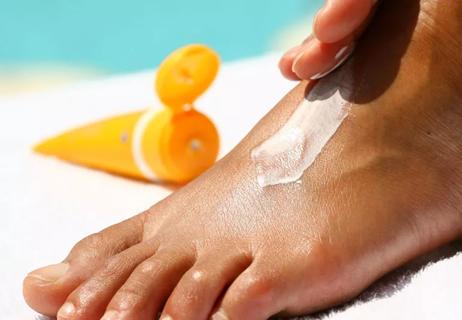SPF makeup offers some protection, but you’re better off pairing it with sunscreen

Multitasking is all the rage in our go-go-go lives. So, if you apply makeup with a built-in sunscreen … well, it stands to reason you’re now a step ahead in your skin care and beauty routine.
Advertisement
Cleveland Clinic is a non-profit academic medical center. Advertising on our site helps support our mission. We do not endorse non-Cleveland Clinic products or services. Policy
But those two-in-one cosmetic products may not deliver all the protection you need to guard against the sun’s damaging rays, says dermatologist Amy Kassouf, MD. Here’s why.
It’s pretty easy these days to find makeup that includes a built-in sun protection factor (SPF). Products ranging from concealers and moisturizers to eye shadow and lipstick routinely offer SPF 30 and above.
Unfortunately, the SPF in makeup probably isn’t enough to limit the harmful effects of the sun’s skin-burning ultraviolet (UV) rays, says Dr. Kassouf.
In fact, at best you’re probably getting about half the protection you think. The reason? Skin care companies slather on an extra thick layer of a product when testing for SPF. In the real world, you’re not spackling your face with that much of the product.
“We put on just as much as we feel we can spread easily, then we’re off to the races,” says Dr. Kassouf. “So, we don’t usually get the full protection listed on the label.”
To be fair, that’s not just a makeup issue. The same dynamic takes place with sunscreen. Research shows you’re probably not layering on enough of that protection-from-the-sun product, either.
The solution? Double up. “Apply sunscreen with at least SPF 30 and makeup with SPF 30,” advises Dr. Kassouf. “Together, they’ll add up to the protection you need.”
Advertisement
Sunscreen also will help keep your skin protected when your makeup inevitably rubs off.
The order of application for skin care and beauty products is important to maximize protection from the sun.
In general, you’re better off applying sunscreen after washing and moisturizing your face but before digging into your makeup supply. “Sunscreen works best when applied directly to clean skin,” says Dr. Kassouf.
Give the sunscreen a few minutes to dry and sink into your skin before starting to put on any makeup. If you start the makeup process too early, you may undermine your sunscreen’s SPF.
If you’ve read this far, clearly you’re interested in keeping your face from looking like tanned leather. Dr. Kassouf offers these five suggestions to maximize your protection:
Getting a base layer of sunscreen on your face and topping it with SPF makeup is a good way to start any day, including cloudy ones. It’s not the end of your defensive work against pesky UV rays, though.
Sunscreen should be reapplied about every two hours or more frequently if you’re swimming, sweating or otherwise weakening the previous protective layer.
The reapplication rule applies even if you’re indoors, too. You can catch rays if you’re sitting by a window, after all. Plus, you’re going back outside eventually — so it’s best to just make regular reapplications part of your routine.
Mineral powder sunscreens are ideal for touch-ups during the day, notes Dr. Kassouf.
“Mineral powders are great for reapplying,” she continues. “They matte any shininess and add SPF at the same time. The minerals are also broad-spectrum by nature, which is what you want.”
Another option? Try using mineral-based tinted sunblock, which Dr. Kassouf calls “one of the best new products” for protection against the sun.
“There is some iron oxide added to the sunblock base of zinc and titanium to give it a tan color,” she explains. “This way, you get the broadest spectrum sun protection in a product that can even your skin tone, as well — and it is just one product to reapply.”
Advertisement
Unless you’ve been living under a rock, you know that sunscreen is super important. (On the bright side, if you are living under a rock, you probably don’t need to worry about sun protection.)
Sun exposure is the top cause of skin cancer — including potentially deadly melanoma. Sunlight also ages your skin by damaging skin cells, leading to fine lines, wrinkles and discoloration.
UVA and UVB rays can cause eye damage (including cataracts) and suppress your immune system, too.
The SPF rating in sunscreen and makeup measures protection against the solar power of UVB rays. These are the bits of sunshine that are responsible for glowing red sunburn and most melanomas.
It’s the sun’s UVA rays that cause wrinkles and other signs of aging that can make you look like a Shar Pei puppy. A broad-spectrum sunscreen (as mentioned above) will offer protection on this front.
In a perfect world, your sunscreen and makeup will offer broad-spectrum protection, says Dr. Kassouf. But if only one hits that standard, it’s better if it’s the base layer of a high-SPF sunscreen.
Advertisement
Learn more about our editorial process.
Advertisement

Polarized lenses have an added benefit of a special coating that reduces glare on reflective surfaces like water and snow

Even on cloudy days or simply running errands, sunscreen is a must

Having darker skin tones doesn’t automatically offer protection from the sun

It’s easy to forget your ears, eyelids, lips and feet — but any exposed skin needs protection

More than just fashionable, the lenses reflect or block harmful UV rays and can reduce glare

Choose lotion-based options that contain titanium dioxide or zinc oxide

Research shows that umbrella shade is less effective than sunscreen for preventing sunburn

An expert weighs in on sunscreen ingredients, application tips and more

Type 2 diabetes isn’t inevitable with these dietary changes

Applying a hot or cold compress can help with pain